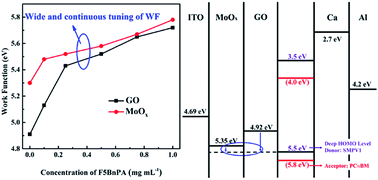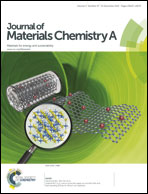Efficient hole transport layers with widely tunable work function for deep HOMO level organic solar cells†
Abstract
Hole transport layers (HTLs) with large work function (WF) tuning ability for good energy level alignment with deep highest occupied molecular orbital (HOMO) level donor materials are desirable for high-performance and high open-circuit voltage (VOC) organic solar cells (OSCs). Here, a novel low-temperature and solution-process approach to achieve WF tuning in HTLs is proposed. Specifically, the HTLs made from 2,3,4,5,6-pentafluorobenzylphosphonic acid (F5BnPA) incorporated graphene oxide (GO) and molybdenum oxide (MoOx) solution (representing two possible classes of HTLs where carriers transport via valence and conduction bands, respectively) offer continuous WF tuning (the tuning range as large as 0.81 eV) by controlling F5BnPA's concentration. By employing a deep HOMO donor material, OSCs using the composite HTLs can achieve improved performances with largely increased VOC (0.92 V for GO:F5BnPA versus 0.65 V for pristine GO; 0.91 V for MoOx:F5BnPA versus 0.88 V for pristine MoOx). The enhanced performance can be experimentally and theoretically explained by the decreased hole injection barrier (HIB) for GO or equivalent HIB (i.e. electron extraction barrier) for MoOx and enhanced surface recombination velocity, which contribute to eliminating S-shaped current–voltage characteristics. Consequently, the incorporation of F5BnPA can efficiently tune HTL WF for high VOC OSCs and extend HTL applications in organic electronics.



 Please wait while we load your content...
Please wait while we load your content...